Prediction and Evaluation of Ecosystem Service Value Based on Land Use of the Yellow River Source Area
Abstract
1. Introduction
2. Materials and Methods
2.1. Study Area
2.2. Data Sources
2.3. Land Use Transfer Matrix Model
2.4. Ecosystem Service Value Model
2.5. PLUS Model
- (1)
- Natural development scenario (NDS): Ruling out the influences arising from policy and regional planning, the land use in 2030 was simulated according to the rate of land use change in the YRSA in 2000, 2010 and 2020. In this scenario, the transfer direction of land use types is not limited in the transfer matrix when the transfer direction is in order;
- (2)
- Ecological protection scenario (EPS): Based on the NDS, this scenario is aimed at ecological protection where the probability of the ecological land (e.g., forest, water area) transferring to anthropogenic land (e.g., farmland, construction land) shall be reduced and the probability of grassland transferring to ecological land (e.g., forest, wetland) shall be increased while the rapid expansion of construction land shall be slowed. In addition, the large water area is considered a restricted development area in this scenario;
- (3)
- Carbon neutral scenario (CNS): The goal of this scenario is to respond to the call of carbon neutral plans proposed by China. Based on EPS, the probability of construction land used for solar and water facilities in the YRSA shall be increased and the transferring probability that certain land use types (e.g., forest, water area) could contribute to the goal of carbon neutrality shall be increased to a lesser extent. In addition, the forest is considered a restricted development area in this scenario;
- (4)
- Production priority scenario (PPS): This scenario is aimed for food security. Based on EPS, the retention of farmland in the YRSA is guaranteed and the amount of farmland replenishment is increased. The probability of transferring grassland to farmland is increased while the probability that farmland transferring to other land use types is reduced. Meanwhile, the probability of transferring to farmland is increased with the intact wetland and water area. In this scenario, the water area and wetland that supply water resources for farmland are considered restricted development areas.
3. Results and Analysis
3.1. Land Use Change from 2000 to 2020
3.2. Change in the Ecosystem Services Value from 2000 to 2020
3.3. Changes in the Ecosystem Services Value by Function
3.4. Future Changes in Land Use and Ecosystem Service Value under Different Scenarios
3.4.1. Land Use Changes in 2030
3.4.2. Changes in ESV under Different Scenarios in 2030
3.5. Discussion
4. Conclusions
Author Contributions
Funding
Institutional Review Board Statement
Informed Consent Statement
Data Availability Statement
Acknowledgments
Conflicts of Interest
References
- Costanza, R.; d’Arge, R.; de Groot, R.; Farber, S.; Grasso, M.; Hannon, B.; Limburg, K.; Naeem, S.; O’Neill, R.V.; Paruelo, J.; et al. The value of the world’s ecosystem services and natural capital. Nature 1997, 387, 253–260. [Google Scholar] [CrossRef]
- MEA. Millennium Ecosystem Assessment. Ecosystems and Human Well-Being; Island Press: Washington, DC, USA, 2005. [Google Scholar]
- Braat, L.C.; de Groot, R. The ecosystem services agenda:bridging the worlds of natural science and economics, conservation and development, and public and private policy. Ecosyst. Serv. 2012, 1, 4–15. [Google Scholar] [CrossRef]
- Calvin, K.; Bond-Lamberty, B.; Clarke, L.; Edmonds, J.; Eom, J.; Hartin, C.; Kim, S.; Kyle, P.; Link, R.; Moss, R. The SSP4: A world of deepening inequality. Glob. Environ. Change 2016, 42, 284–296. [Google Scholar] [CrossRef]
- Polasky, S.; Nelson, E.; Pennington, D.; Johnson, K.A. The Impact of Land-Use Change on Ecosystem Services, Biodiversity and returns to landowners: A Case Study in the State of Minnesota. Environ. Resour. Econ. 2011, 48, 219–242. [Google Scholar] [CrossRef]
- Deng, X.Z.; Huang, J.K.; Rozelle, S.; Zhang, J.P.; Li, Z.H. Impact of urbanization on cultivated land changes in China. Land Use Policy 2015, 45, 1–7. [Google Scholar] [CrossRef]
- Blignaut, J.; Moolman, C. Quantifying the potential of restored natural capital to alleviate poverty and help conserve nature: A case study from South Africa. J. Nat. Conserv. 2022, 14, 237–248. [Google Scholar] [CrossRef]
- Ten Brink, P.; Kettunen, M.; Vakrou, A.; Wittmer, H.; Armstrong, J.; Rayment, M.; Ruhweza, A.; Shine, C.; Berghöfer, A.; Neuville, A.; et al. The Economics of Ecosystems and Biodiversity in National and International Policy Making; Earthscan: London, UK; Washington, DC, USA, 2011; ISBN 9781849775496. [Google Scholar]
- Xie, G.D.; Lu, C.X.; Zheng, D.; Li, S.C. Ecological assets valuation of the Tibetan Plateau. J. Nat. Resour. 2003, 18, 189–196. [Google Scholar]
- Daily, G.; Postel, S.; Bawa, K.; Kaufman, L. Nature’s Service: Social Dependence on Natural Ecosystems; Island Press: Washington, DC, USA, 1997; ISBN 1-55963-476-6. [Google Scholar]
- Samantha, S.K.S.; Van Teeffelen, A.J.; Verburg, P.H. Integrating socio-cultural perspectives into ecosystem service valuation: A review of concepts and methods. Ecol. Econ. 2015, 114, 67–68. [Google Scholar]
- De Groot, R.; Brander, L.; van der Ploeg, S.; Costanza, R.; Bernard, F.; Braat, L.; Christie, M.; Crossman, N.; Ghermandi, A.; Hein, L.; et al. Global estimates of the value of ecosystems and their services in monetary units. Ecosyst. Serv. 2012, 1, 50–61. [Google Scholar] [CrossRef]
- Zhang, X.B.; Liu, J.; Shi, P.J.; Zhou, L. Spatial-temporal evolution pattern and terrain gradient differentiation of ecosystem service value in Zhangye, Northwest China at the grid scale. J. Appl. Ecol. 2020, 31, 543–553. [Google Scholar]
- He, C.J.; Shao, H.Y.; Xian, W. Spatiotemporal Variation and Driving Forces Analysis of Eco-System Service Values: A Case Study of Sichuan Province, China. Int. J. Environ. Res. Public Health 2022, 19, 8595. [Google Scholar] [CrossRef] [PubMed]
- Xie, G.D.; Zhen, L.; Lu, C.X.; Xiao, Y.; Li, W.H. Applying Value Transfer Method for Eco-Service Valuation in China. J. Resour. Ecol. 2010, 1, 51–59. [Google Scholar]
- Ye, Y.Q.; Zhang, J.E.; Wang, T.; Bai, H.; Wang, X.; Zhao, W. Changes in Land-Use and Ecosystem Service Value in Guangdong Province, Southern China, from 1990 to 2018. Ecol. Indic. 2021, 10, 426. [Google Scholar] [CrossRef]
- Gao, X.; Shen, J.Q.; He, W.J.; Zhao, X.; Li, Z.C.; Hu, W.F.; Wang, J.Z.; Ren, Y.J.; Zhang, X. Spatial-temporal analysis of ecosystem services value and research on ecological compensation in Taihu Lake Basin of Jiangsu Province in China from 2005 to 2018. J. Clean. Prod. 2021, 317, 128241. [Google Scholar] [CrossRef]
- Guo, X.M.; Fang, C.L.; Mu, X.F.; Chen, D. Coupling and coordination analysis of urbanization and ecosystem service value in Beijing-Tianjin-Hebei urban agglomeration. Ecol. Indic. 2022, 137, 108782. [Google Scholar]
- Niu, Y.N.; Xie, G.D.; Xiao, Y.; Qin, K.Y.; Gan, S.; Liu, J.Y. Spatial and Temporal Changes of Ecosystem Service Value in Airport Economic Zones in China. Land 2021, 10, 1054. [Google Scholar] [CrossRef]
- Deng, X.; Li, Z.; Huang, J.; Shi, Q.G.; Li, Y.F. A Revisit to the Impacts of Land Use Changes on the Human Wellbeing via Altering the Ecosystem Provisioning Services. Adv. Meteorol. 2013, 2013, 907367. [Google Scholar] [CrossRef]
- Zhang, D.; Wang, X.R.; Qu, L.P.; Li, S.C.; Lin, Y.P.; Yao, R.; Zhou, X.; Li, J.Y. Land use/cover predictions incorporating ecological security for the Yangtze River Delta region, China. Ecol. Indic. 2020, 119, 106841. [Google Scholar] [CrossRef]
- Tang, Z.X.; Zhou, Z.X.; Wang, D.; Luo, F.B.; Bai, J.Z.; Fu, Y. Impact of vegetation restoration on ecosystem services in the Loess plateau, a case study in the Jinghe Watershed, China. Ecol. Indic. 2022, 142, 109183. [Google Scholar] [CrossRef]
- Duan, X.Y.; Chen, Y.; Wang, L.Q.; Zheng, G.D.; Tao, L. The impact of land use and land cover changes on the landscape pattern and ecosystem service value in San jiang yuan region of the Qinghai-Tibet Plateau. J. Environ. Manag. 2023, 325, 116539. [Google Scholar] [CrossRef]
- Fan, F.F.; Xiao, C.W.; Feng, Z.M.; Chen, Y. Land-planning management based on multiple ecosystem services and simulation in tropical forests. J. Environ. Manag. 2022, 325, 116216. [Google Scholar] [CrossRef] [PubMed]
- Williams, A.; Hedlund, K. Indicators of soil ecosystem services in conventional and organic arable fields along a gradient of landscape heterogeneity in southern Sweden. Appl. Soil Ecol. 2013, 65, 1–7. [Google Scholar] [CrossRef]
- Xia, C.; Li, Y.; Xu, T.; Ye, Y.; Shi, Z.; Peng, Y.; Liu, J. Quantifying the spatial patterns of urban carbon metabolism: A case study of Hangzhou, China. Ecol. Indic. 2018, 95, 474–484. [Google Scholar] [CrossRef]
- Tang, F.; Fu, M.C.; Wang, L.; Zhang, P.T. Land-use change in Changli County, China: Predicting its spatio-temporal evolution in habitat quality. Ecol. Indic. 2020, 127, 106719. [Google Scholar] [CrossRef]
- Xiao, Y.; Huang, M.L.; Xie, G.D.; Zhen, L. Evaluating the impacts of land use change on ecosystem service values under multiple scenarios in the Hunshandake region of China. Sci. Total Environ. 2022, 850, 158067. [Google Scholar] [CrossRef]
- Ding, Q.L.; Chen, Y.; Bu, L.T.; Ye, Y.M. Multi-Scenario Analysis of Habitat Quality in the Yellow River Delta by Coupling FLUS with In VEST Model. Int. J. Environ. Res. Public Health 2021, 18, 2389. [Google Scholar] [CrossRef] [PubMed]
- Sun, J.F.; Zhang, Y.; Qin, W.S. Estimation and Simulation of Forest Carbon Stock in Northeast China Forestry Based on Future Climate Change and LUCC. Remote Sens. 2022, 14, 3653. [Google Scholar] [CrossRef]
- Liang, X.; Guan, Q.; Clarke, K.C.; Liu, S.; Wang, B.; Yao, Y. Understanding the drivers of sustainable land expansion usinga patch-generating land use simulation (PLUS) model: A case study in Wuhan, China. Comput. Environ. Urban Syst. 2021, 85, 101569. [Google Scholar] [CrossRef]
- Yang, J.; Wang, Y.C.; Guo, L.; Xue, D. Patterns and structures of land use change in the Three Rivers Headwaters region of China. PLoS ONE 2015, 10, e119121. [Google Scholar] [CrossRef][Green Version]
- Yu, H.; Luedeling, E.; Xu, J. Winter and spring warming result in delayed spring phenology on the Tibetan Plateau. Proc. Natl. Acad. Sci. USA 2010, 107, 22151–22156. [Google Scholar] [CrossRef]
- Chen, Q.; Zhou, Q.; Zhang, H.F.; Liu, F.G. Spatial disparity of NDVI response in vegetation growing season to climate change in the Three-River Headwaters Region. Ecol. Environ. 2010, 19, 1284–1289. [Google Scholar]
- Ding, M.; Zhang, Y.; Sun, X.; Liu, L.; Wang, Z.; Bai, W. Spatiotemporal variation in alpine grassland phenology in the Qinghai-Tibetan Plateau from 1999 to 2009. Sci. Bull. 2012, 57, 3185–3194. [Google Scholar] [CrossRef]
- Wang, G.X.; Liu, G.S.; Li, C.J. Efects of changes in alpine grass land vegetation cover on hllslope hydrological processes in a permafrost watershed. J. Hydrol. 2012, 444–445, 22–33. [Google Scholar]
- Liu, J.Y.; Bing, L.F.; Shao, Q.Q. Characteristic of Land Cover Changes in the Yellow River Headwaters Region over the Past 30 Years. Geo-Spat. Inf. Sci. 2011, 13, 289–296. [Google Scholar]
- Huang, L.; Shao, Q.; Liu, J. Spatial-temporal Analysis of Soil Erosion in Grassland over the Past Three Decades in Sanjiangyuan Region, Qinghai Province, China. Geo-Spat. Inf. Sci. 2011, 13, 12–21. [Google Scholar] [CrossRef]
- Wu, X.F.; Li, G.X.; Pan, X.P.; Wang, Y.; Zhang, S.; Liu, G.; Shen, Y. Response of vegetation cover to temperature and precipitation in the source region of the Yellow River. Resour. Sci. 2015, 37, 512–521. [Google Scholar]
- Liu, L.L.; Cao, W.; Shao, Q.Q. Different Characteristics of Land Cover Changes in Source Regions of the Yangtze River and the Yellow River in the Past 30 Year. Sci. Geogr. Sin. 2017, 37, 311–320. [Google Scholar]
- Zhang, L.; Fan, J.; Shao, Q.; Tang, F.; Zhang, H.; Li, Y. Changes in grassland yield and grazing pressure in the Three Rivers headwater region before and after the implementation of the eco-restoration project. Acta Prataculturae Sin. 2014, 23, 116–123. [Google Scholar]
- Zhang, Y.; Liu, L.; Wang, Z.; Bai, W.; Ding, M.; Wang, X.; Yan, J.; Xu, E.; Wu, X.; Zhang, B.; et al. Spatial and temporal characteristics of land use and cover changes in the Tibetan Plateau. Chin. Sci. Bull. 2019, 64, 2865–2875. [Google Scholar]
- Chen, Q.; Zhang, Y.L.; Liu, F.G.; Zhou, Q.; Wang, S.Z.; Cheng, Y.; Guo, R.; Zhi, Z.M.; Xu, H.Y. A review of land use change and its influence in the source region of Yellow River. Resour. Sci. 2020, 42, 446–459. [Google Scholar] [CrossRef]
- Sun, S.; Shi, Q. Global Spatio—Temporal Assessment of Changes in Multiple Ecosystem Services Under Four IPCC SRES Land-use Scenarios. Earth’s Future 2020, 8, e2020EF001668. [Google Scholar] [CrossRef]
- Bryan, B.A.; Gao, L.; Ye, Y.; Sun, X.; Connor, J.D.; Crossman, N.D.; Stafford-Smith, M.; Wu, J.; He, C.; Yu, D.; et al. China’s response to a national land-system sustainability emergency. Nature 2018, 559, 193–204. [Google Scholar] [CrossRef] [PubMed]
- Cao, W.; Liu, L.L.; Wu, D.; Huang, L. Spatial and temporal variations and the importance of hierarchy of ecosystem functions in the Three-river-source National Park. Acta Ecol. Sin. 2019, 39, 1361–1374. [Google Scholar]
- Chen, J.; Chen, J.; Liao, A.P. Remote Sensing Mapping of Global Land Cover; Science Press: Beijing, China, 2016; ISBN 9787030494351. [Google Scholar]
- Chen, J.; Ban, Y.; Li, S. Open access to Earth land-cover map. Nature 2014, 514, 434. [Google Scholar]
- Hoque, M.Z.; Islam, I.; Ahmed, M.; Hasan, S.S.; Prodhan, F.A. Spatio-temporal changes of land use land cover and ecosystem service values in coastal Bangladesh. Egypt. J. Remote Sens. Space Sci. 2022, 25, 173–180. [Google Scholar]
- Felipe-Lucia, M.R.; Soliveres, S.; Penone, C.; Fischer, M.; Ammer, C.; Boch, S.; Boeddinghaus, R.S.; Bonkowski, M.; Buscot, F.; Fiore-Donno, A.M.; et al. Land-use intensity alters networks between biodiversity, ecosystem functions, and services. Proc. Natl. Acad. Sci. USA 2020, 117, 28140–28149. [Google Scholar] [CrossRef]
- Fischer, G.; Nachtergaele, F.; Prieler, S.; van Velthuizen, H.T.; Verelst, L.; Wiberg, D. Global Agro-Ecological Zones Assessment for Agriculture (GAEZ 2008); IIASA Laxenburg Austria and FAO: Rome, Italy, 2008. [Google Scholar]
- Zhang, H.; Wang, Z.Q.; Chai, J. Land use\cover change and influencing factors inside the urban development boundary of different level cities: A case study in Hubei Province, China. Heliyon 2022, 8, e10408. [Google Scholar] [CrossRef]
- Hu, Y.; Zhen, L.; Zhuang, D. Assessment of Land-Use and Land-Cover Change in Guangxi, China. Sci. Rep. 2019, 9, 2189. [Google Scholar] [CrossRef]
- Verburg, P.H.; Overmars, K.P. Combining top-down and bottom-up dynamics in land use modeling: Exploring the future of abandoned farmlands in Europe with the Dyna-CLUE model. Landsc. Ecol. 2009, 24, 1167–1181. [Google Scholar] [CrossRef]
- McHugh, M.L. Interrater reliability: The kappa statistic. Biochem. Med. (Zagreb) 2012, 22, 276–282. [Google Scholar] [CrossRef]
- Balian, H.G.; Eddy, N.W. Figure-of-merit (FOM), an improved criterion over the normalized chi-squared test for assessing goodness-of-fit of gamma-ray spectral peaks. Nucleaar Instrum. Methods 1977, 145, 389–395. [Google Scholar] [CrossRef]
- Lou, Y.; Yang, D.; Zhang, P.; Zhang, Y.; Song, M.; Huang, Y.; Jing, W. Multi-Scenario Simulation of Land Use Changes with Ecosystem Service Value in the Yellow River Basin. Land 2022, 11, 992. [Google Scholar] [CrossRef]
- Wang, Z.; Li, X.; Mao, Y.; Li, L.; Wang, X.; Lin, Q. Dynamic simulation of land use change and assessment of carbon storage based on climate change scenarios at the city level: A case study of Bortala, China. Ecol. Indic. 2022, 134, 108499. [Google Scholar] [CrossRef]
- Liu, B.; Pan, L.; Qi, Y.; Guan, X.; Li, J.S. Land Use and Land Cover Change in the Yellow River Basin from 1980 to 2015 and Its Impact on the Ecosystem Services. Land 2021, 10, 1080. [Google Scholar] [CrossRef]
- Zhang, P.; Geng, W.; Yang, D.; Li, Y.; Zhang, Y.; Qin, M. Spatial and temporal evolution of land use and ecosystem service values in the lower reaches of the Yellow River. Trans. Chin. Soc. Agric. Eng. 2020, 36, 277–288. [Google Scholar]
- Liu, X.P.; Liang, X.; Li, X.; Xu, X.C.; Ou, J.P.; Chen, Y.M.; Li, S.Y.; Wang, S.J.; Pei, F.G. A future land use simulation model (FLUS) for simulating multiple land use scenarios by coupling human and natural effects. Landsc. Urban Plan. 2017, 168, 94–116. [Google Scholar] [CrossRef]
- Dong, N.; You, L.; Cai, W.J.; Li, G.; Lin, H. Land use projections in China under global socioeconomic and emission scenarios: Utilizing a scenario-based land-use change assessment framework. Glob. Environ. Change 2018, 50, 164–177. [Google Scholar] [CrossRef]
- Huang, Y.; Huang, J.L.; Liao, T.J.; Liang, X.; Tian, H. Simulating urban expansion and its impact on functional connectivity in the Three Gorges Reservoir Area. Sci. Total Environ. 2018, 643, 1533–1561. [Google Scholar] [CrossRef]
- Zhai, H.; Lv, C.; Liu, W.; Yang, C.; Fan, D.; Wang, Z.; Guan, Q. Understanding Spatio-Temporal Patterns of Land Use/Land Cover Change under Urbanization in Wuhan, China, 2000–2019. Remote Sens. 2021, 13, 3331. [Google Scholar] [CrossRef]
- Zhang, D.; Wang, J.P.; Wang, Y.; Xu, L.; Zhang, L.; Zhang, B.Z.; Bi, Y.Z.; Yang, H. Is There a Spatial Relationship between Urban Landscape Pattern and Habitat Quality? Implication for Landscape Planning of the Yellow River Basin. Environ. Res. Public Health 2022, 19, 11974. [Google Scholar] [CrossRef]
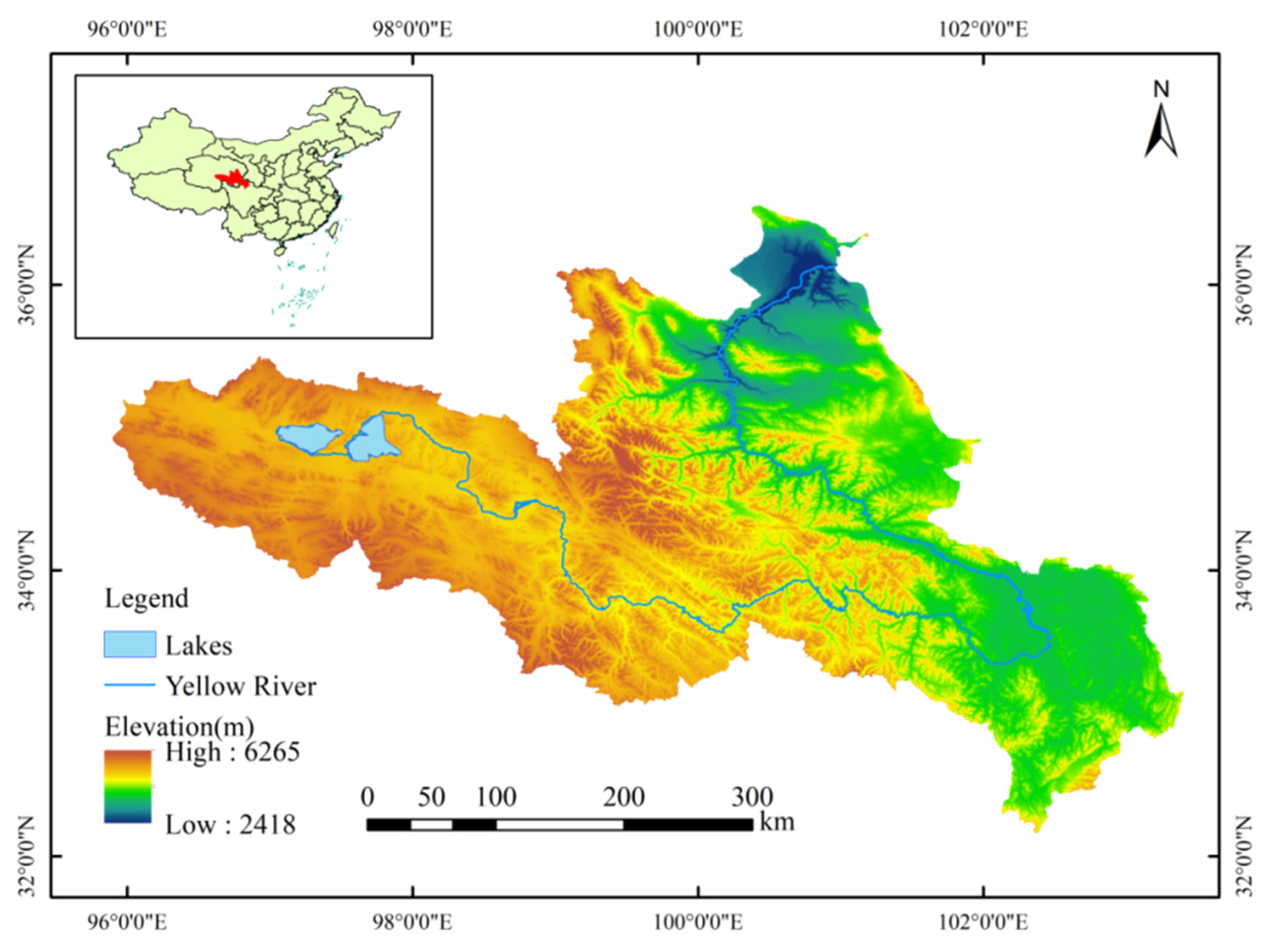



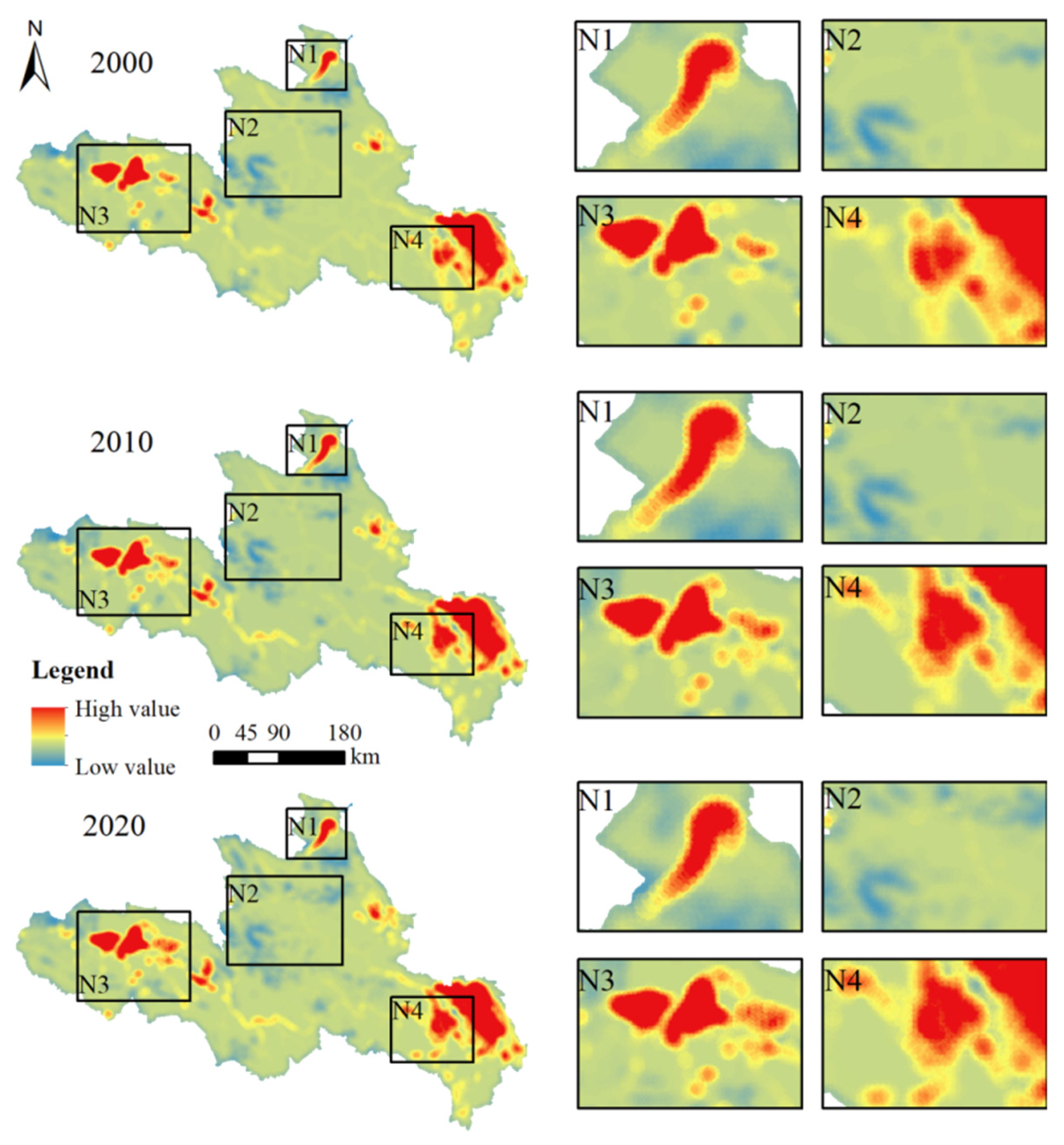
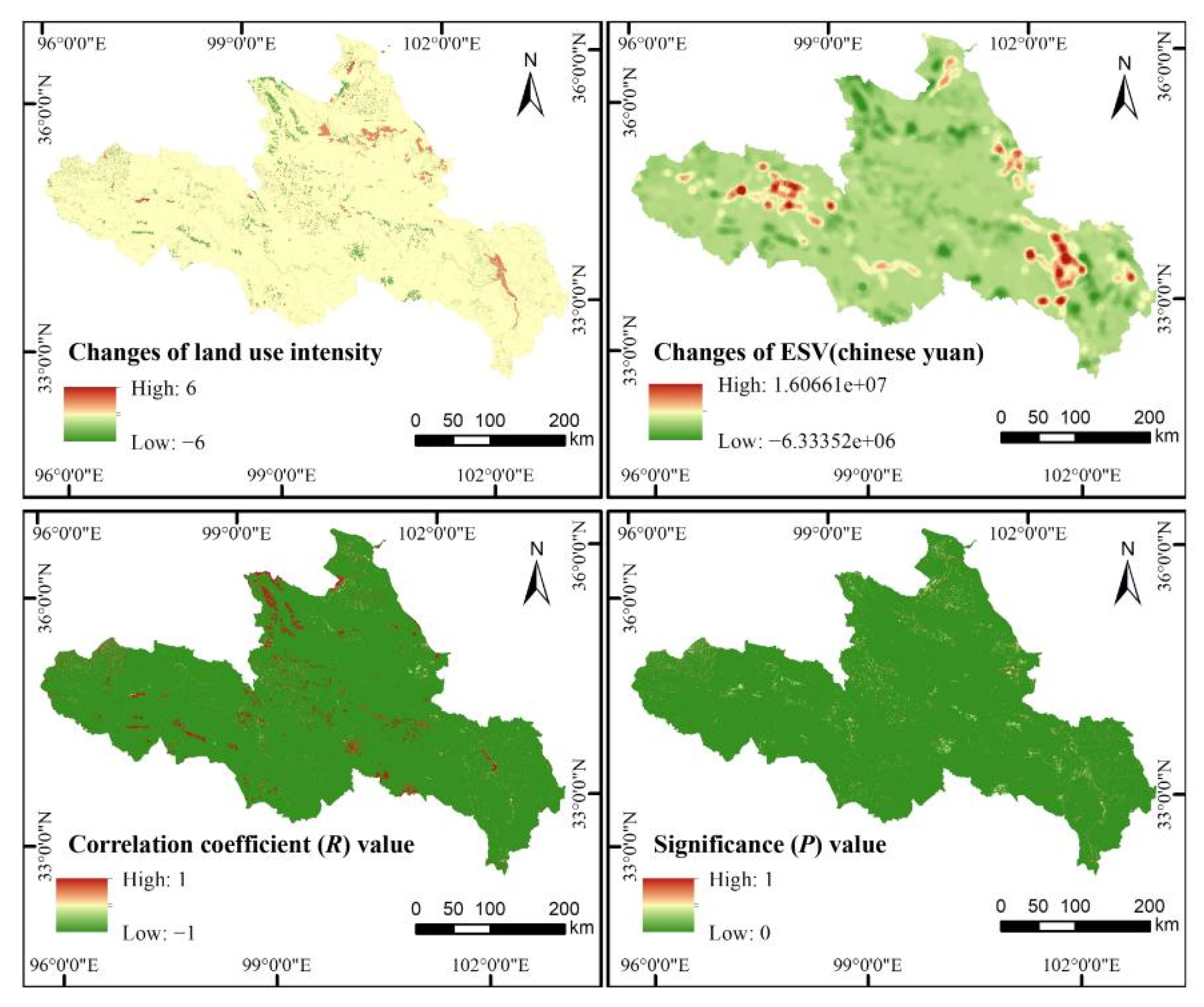
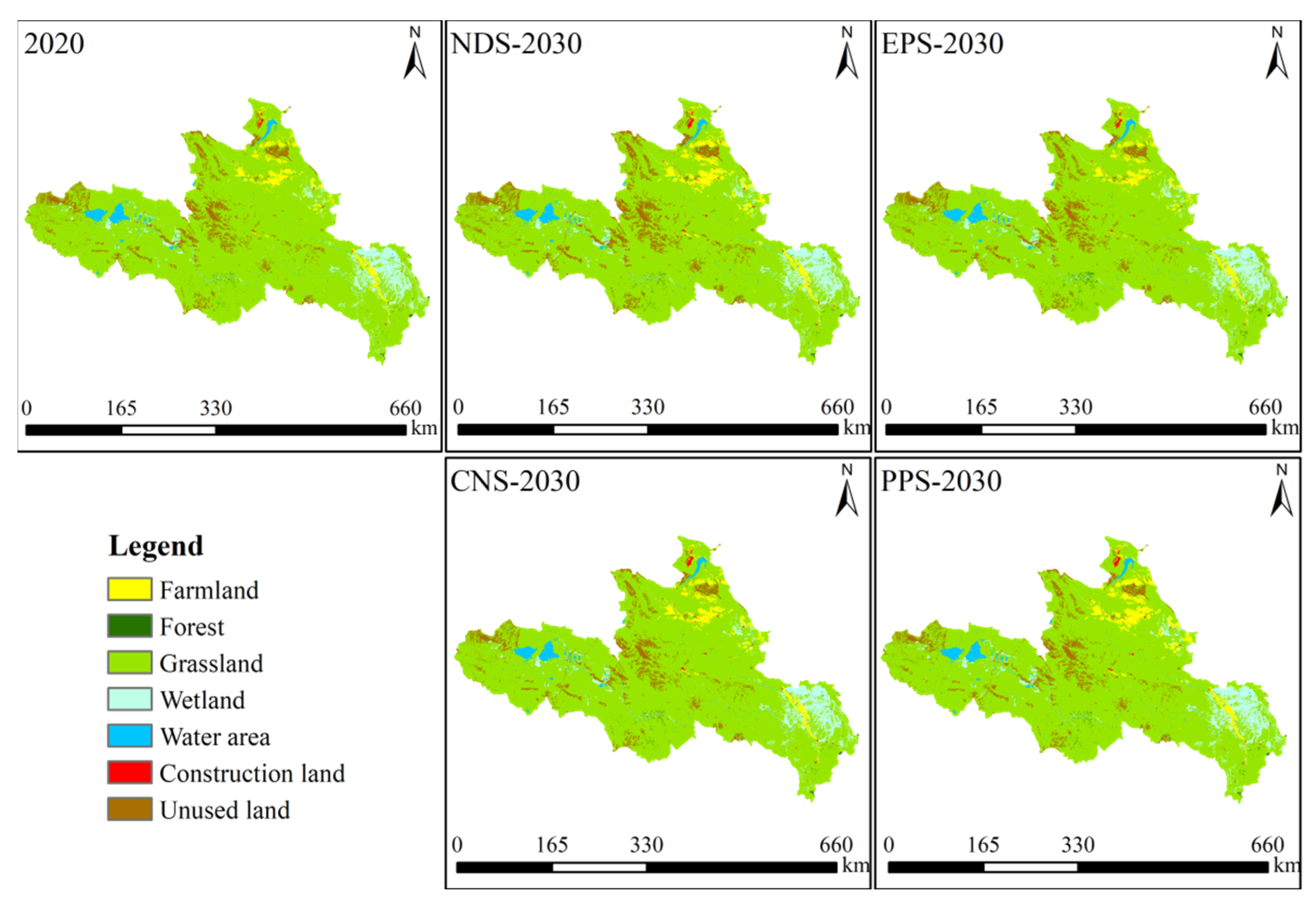
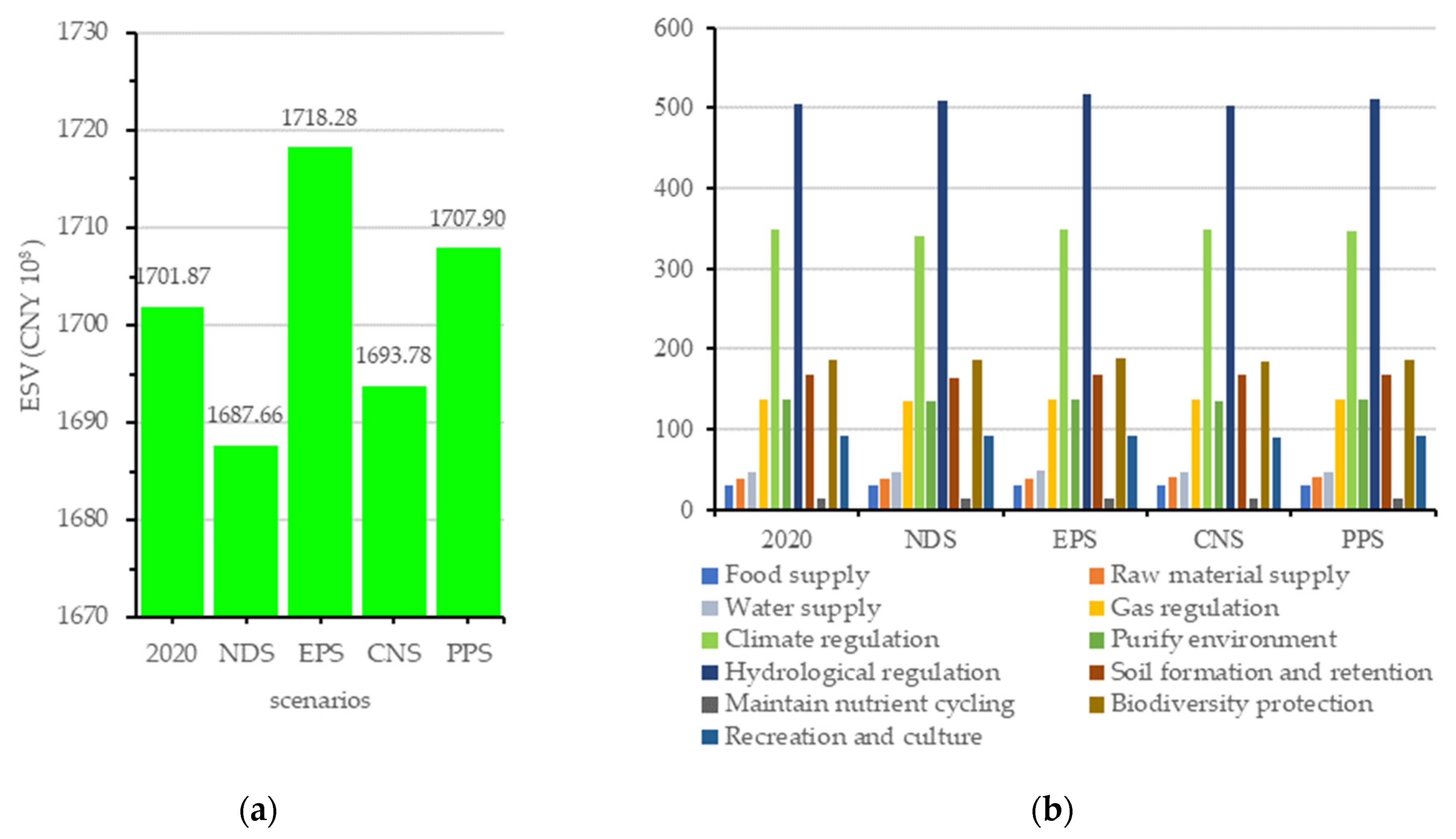
| Macro LULC Classes | Micro LULC Classes Information | Level of Intensity |
|---|---|---|
| Construction land | Surface formed by man-made construction activities, including various residential areas, industrial mines and transportation facilities in towns. | 7 |
| Farmland | Land used for growing crops, including paddy fields, dry land, vegetable fields, pastureland, orchards. | 6 |
| Forest | The land covered by trees with crown coverage over 30% and the land covered by shrubs with shrub coverage over 30% are forest, shrub land, open forest land and immature forest land. | 5 |
| Grassland | The land covered by natural herbaceous vegetation with coverage higher than 10% includes grassland, meadow, savanna and desert grassland. | 4 |
| Wetland | Land with shallow water or over-wet soil, including inland marshes, lake marshes and shrub wetlands. | 3 |
| Water area | Liquid water covered areas and ice-covered areas, including rivers, lakes, glaciers, beaches. | 2 |
| Unused land | Naturally covered land with less than 10% vegetation cover, including saline, sandy, bare rock and bare tundra. | 1 |
| Driving Factors | Data Source |
|---|---|
| Precipitation | NOAA (https://www.noaa.gov/, accessed on 1 October 2021) |
| Temperature | |
| DEM | Geospatial Data Cloud (www.gscloud.cn, accessed on 1 October 2021) |
| Slope | |
| Aspect | |
| Soil type | Harmonized World Soil Database v 1.2 [51] (https://www.fao.org/soils-portal/soil-survey/soil-maps-and-databases/harmonized-world-soil-database-v12/en/, accessed on 1 October 2021) |
| Distance from senior roads | OpenStreetMap (https://www.openstreetmap.org/, accessed on 1 October 2021) |
| Distance from minor roads | |
| Distance from the river |
| Ecosystem Services | Land Use Types | |||||||
|---|---|---|---|---|---|---|---|---|
| Primary Classification | Secondary Classification | Farmland | Forest | Grassland | Wetland | Water Area | Construction Land | Unused Land |
| Provisioning services | Food supply | 777.98 | 231.11 | 213.56 | 466.79 | 366.11 | 0.00 | 4.58 |
| raw material supply | 366.11 | 530.86 | 314.24 | 457.64 | 105.26 | 0.00 | 13.73 | |
| Water supply | 18.31 | 274.58 | 173.90 | 2370.57 | 4782.32 | 0.00 | 9.15 | |
| Regulating services | Gas regulation | 613.24 | 1745.89 | 1104.43 | 1739.02 | 434.76 | 0.00 | 59.49 |
| Climate regulation | 329.50 | 5223.94 | 2919.73 | 3294.99 | 1295.12 | 0.00 | 45.76 | |
| Purify environment | 91.53 | 1530.80 | 964.09 | 3294.99 | 2613.11 | 0.00 | 187.63 | |
| Hydrological regulation | 247.12 | 3418.56 | 2138.70 | 22,177.14 | 50,051.88 | 0.00 | 109.83 | |
| Supporting services | Soil formation and retention | 942.73 | 2125.73 | 1345.46 | 2114.29 | 425.60 | 0.00 | 68.65 |
| Maintain nutrient cycling | 109.83 | 162.46 | 103.73 | 164.75 | 32.03 | 0.00 | 4.58 | |
| Biodiversity protection | 118.99 | 1935.81 | 1223.42 | 7203.22 | 1171.55 | 0.00 | 64.07 | |
| Cultural services | Recreation and culture | 54.92 | 848.92 | 540.01 | 4329.26 | 906.12 | 0.00 | 27.46 |
| Total | 3670.26 | 18,028.65 | 11,041.28 | 47,612.67 | 62,183.86 | 0.00 | 594.93 | |
| Year | Farmland | Forest | Grassland | Wetland | Water Area | Construction Land | Unused Land | Total | |
|---|---|---|---|---|---|---|---|---|---|
| 2000 | ESV | 5.8 | 6.13 | 1283.73 | 263.1 | 132.96 | 0 | 2.95 | 1694.66 |
| Proportion (%) | 0.34% | 0.36% | 75.75% | 15.53% | 7.85% | 0.00% | 0.17% | ||
| 2010 | ESV | 7.72 | 4.56 | 1261.59 | 296.21 | 146.98 | 0 | 3.31 | 1720.38 |
| Proportion (%) | 0.45% | 0.27% | 73.33% | 17.22% | 8.54% | 0.00% | 0.19% | ||
| 2020 | ESV | 12.08 | 4.93 | 1215.7 | 315.23 | 149.24 | 0 | 4.69 | 1701.87 |
| Proportion (%) | 0.71% | 0.29% | 71.43% | 18.52% | 8.77% | 0.00% | 0.28% | ||
| Primary Classification | Secondary Classification | 2000 | 2010 | 2020 | |
|---|---|---|---|---|---|
| Provisioning services | Food supply | 29.52 | 29.89 | 30.14 |  |
| Raw material supply | 40.12 | 39.98 | 39.34 | ||
| Water supply | 43.71 | 46.08 | 46.53 | ||
| Regulating services | Gas regulation | 140.80 | 140.10 | 137.13 | |
| Climate regulation | 362.97 | 359.44 | 349.27 | ||
| Purify environment | 137.48 | 138.46 | 136.44 | ||
| Hydrological regulation | 480.32 | 502.64 | 505.05 | ||
| Supporting services | Soil formation and retention | 171.58 | 170.80 | 167.39 | |
| Maintain nutrient cycling | 13.29 | 13.25 | 13.03 | ||
| Biodiversity protection | 185.71 | 188.47 | 186.63 | ||
| Cultural services | Recreation and culture | 89.16 | 91.26 | 90.92 | |
| Total | 1694.66 | 1720.38 | 1701.87 | ||
| LULC | Area (km2) | ||||
|---|---|---|---|---|---|
| NDS | EPS | CNS | PPS | ||
| Farmland | 4398.39 | 3254.30 | 3723.96 | 4798.71 |  |
| Forest | 287.39 | 473.55 | 297.00 | 285.50 | |
| Grassland | 106,383.85 | 108,890.31 | 110,199.61 | 108,593.89 | |
| Wetland | 7011.14 | 7062.83 | 6266.29 | 6931.61 | |
| Water area | 2444.72 | 2480.58 | 2496.06 | 2439.40 | |
| Construction land | 477.89 | 366.41 | 443.75 | 441.84 | |
| Unused land | 9885.73 | 8361.13 | 7462.44 | 7398.14 | |
| Total | 130,889.11 | 130,889.11 | 130,889.11 | 130,889.11 | |
| Primary Classification | Secondary Classification | 2020 | NDS | EPS | CNS | PPS |
|---|---|---|---|---|---|---|
| Provisioning services | Food supply | 30.14 | 30.42 | 30.14 | 30.37 | 31.15 |
| Raw material supply | 39.34 | 38.80 | 39.27 | 39.38 | 39.56 | |
| Water supply | 46.53 | 47.06 | 47.81 | 46.17 | 47.22 | |
| Total | 116.01 | 116.28 | 117.22 | 115.93 | 117.93 | |
| Regulating services | Gas regulation | 137.13 | 134.54 | 136.94 | 136.94 | 136.93 |
| Climate regulation | 349.27 | 340.28 | 348.34 | 348.75 | 346.48 | |
| Purify environment | 136.44 | 134.75 | 137.33 | 135.61 | 136.17 | |
| Hydrological regulation | 505.05 | 508.53 | 517.02 | 502.34 | 511.04 | |
| Total | 1127.88 | 1118.10 | 1139.63 | 1123.64 | 1130.62 | |
| Supporting services | Soil formation and retention | 167.39 | 164.43 | 167.14 | 167.23 | 167.44 |
| Maintain nutrient cycling | 13.03 | 12.84 | 13.01 | 13.03 | 13.09 | |
| Biodiversity protection | 186.63 | 185.23 | 188.84 | 184.38 | 187.24 | |
| Total | 367.05 | 362.51 | 368.99 | 364.65 | 367.77 | |
| Cultural services | Recreation and culture | 90.92 | 90.77 | 92.44 | 89.56 | 91.57 |
| Total | 90.92 | 90.77 | 92.44 | 89.56 | 91.57 | |
| Total | 1701.87 | 1687.66 | 1718.28 | 1693.78 | 1707.90 | |
Disclaimer/Publisher’s Note: The statements, opinions and data contained in all publications are solely those of the individual author(s) and contributor(s) and not of MDPI and/or the editor(s). MDPI and/or the editor(s) disclaim responsibility for any injury to people or property resulting from any ideas, methods, instructions or products referred to in the content. |
© 2022 by the authors. Licensee MDPI, Basel, Switzerland. This article is an open access article distributed under the terms and conditions of the Creative Commons Attribution (CC BY) license (https://creativecommons.org/licenses/by/4.0/).
Share and Cite
Lu, Z.; Song, Q.; Zhao, J.; Wang, S. Prediction and Evaluation of Ecosystem Service Value Based on Land Use of the Yellow River Source Area. Sustainability 2023, 15, 687. https://doi.org/10.3390/su15010687
Lu Z, Song Q, Zhao J, Wang S. Prediction and Evaluation of Ecosystem Service Value Based on Land Use of the Yellow River Source Area. Sustainability. 2023; 15(1):687. https://doi.org/10.3390/su15010687
Chicago/Turabian StyleLu, Zhibo, Qian Song, Jianyun Zhao, and Shiru Wang. 2023. "Prediction and Evaluation of Ecosystem Service Value Based on Land Use of the Yellow River Source Area" Sustainability 15, no. 1: 687. https://doi.org/10.3390/su15010687
APA StyleLu, Z., Song, Q., Zhao, J., & Wang, S. (2023). Prediction and Evaluation of Ecosystem Service Value Based on Land Use of the Yellow River Source Area. Sustainability, 15(1), 687. https://doi.org/10.3390/su15010687







